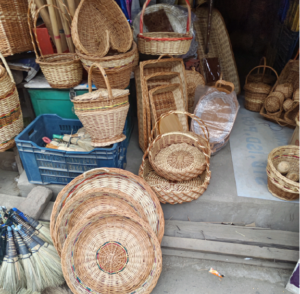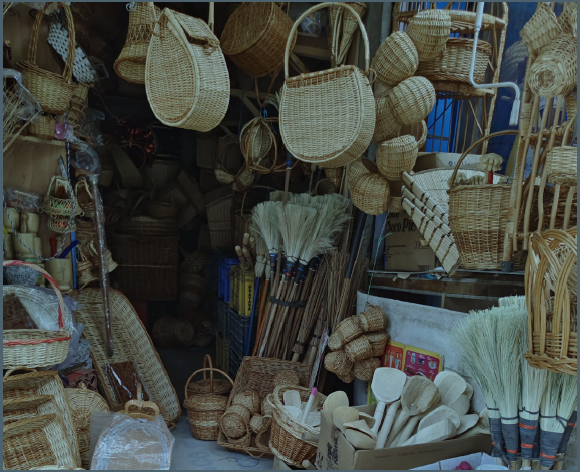The rich culture of Kashmir is epitomized by its iconic wicker craft. From Kangris to intricately designed baskets, each piece tells a story of tradition and artistry. Kashmir’s wicker craft, or Keani Keam, is more than an art form—it’s a symbol of cultural identity and a testament to the enduring spirit of its artisans.
By Manzoor Akash
In the beautiful scenery of Kashmir, a traditional yet ever-changing craft flourishes—wicker craft, known locally as Keani Keam. For centuries, this wonderful art has decorated homes and brought joy, showcasing the rich culture of the Valley.
At its core, wicker craft, also known as shaakhsaazi, is a testament to the ingenuity and resourcefulness of the Kashmiri people. From the cultivation of willow saplings to the meticulous weaving process, every step is a labor of love and dedication. However, it is in the district of Ganderbal, blessed with optimal soil and climatic conditions, that this thriving industry finds its epicenter. Here, the growth of willow crops forms the foundation of these beautiful creations.
The journey of a willow sapling from tender shoot to sturdy reed mirrors the resilience of Kashmiri artisans. Through meticulous harvesting and processing, these artisans transform raw materials into functional works of art. The age-old tradition of boiling, peeling, and drying the withy is not just a means to an end but a ritual that honors the craft’s heritage.
What sets willow wicker craft apart is its dual role as both a utilitarian object and a symbol of cultural identity. From the iconic Kangri, providing warmth during harsh winters, to a wide range of products, including intricately woven baskets, chairs, tables, vases, trays, cradles, and wall plates, these creations embody the essence of Kashmiri life. The wonderful artistry extends beyond mere functionality, with artisans infusing each piece with vibrant colors, geometric patterns, and ornate embellishments, adding a touch of elegance to everyday rituals.
Yet, the story of this craft is not confined to the annals of Kashmiri history. It is a tale of cultural exchange and adaptation, transcending borders and centuries. Introduced to the valley during the 19th century by Europeans, the craft flourished under royal patronage, blending foreign techniques with local craftsmanship. What emerged was a fusion of tradition and innovation, laying the groundwork for a thriving handicraft industry. This ancient craft, practiced in Srinagar’s Dalgate, Nawakadal, and Habbakadal areas, found its strongest roots in Ganderbal, the largest producer of willow baskets in the valley.

Besides the most widely used wicker material of willow sticks, locally known as Veer Kaeni, this timeless artistry also utilizes other materials like cane, bamboo, hyacinth, moonj, and sabai. Nevertheless, willow wicker has stood the test of time, becoming synonymous with the craft itself.
Today, as artisans strive to expand their market reach, they continue to embrace change while staying true to their roots. Innovations in design and production techniques breathe new life into age-old traditions, ensuring the craft remains relevant in a rapidly evolving world. From modern twists on traditional patterns to sustainable practices that preserve the environment, these artisans are pioneers of progress, carving a path for future generations.
As we marvel at the beauty of willow wicker craft, let us also celebrate the resilience of Kashmiri artisans, whose unwavering dedication keeps this ancient tradition alive. In their hands, a simple reed becomes a symbol of heritage, a vessel for storytelling, and a beacon of hope for the future. May their art continue to weave together the threads of culture, community, and creativity, enriching our lives and inspiring generations to come.
The views expressed in this article are solely those of the author and do not necessarily reflect the opinions or views of this Magazine. The author can be reached at [email protected]
Blurb
Introduced to the valley during the 19th century by Europeans, the craft flourished under royal patronage, blending foreign techniques with local craftsmanship. What emerged was a fusion of tradition and innovation, laying the groundwork for a thriving handicraft industry. This ancient craft, practiced in Srinagar’s Dalgate, Nawakadal, and Habbakadal areas, found its strongest roots in Ganderbal, the largest producer of willow baskets in the valley.

Leave a Reply